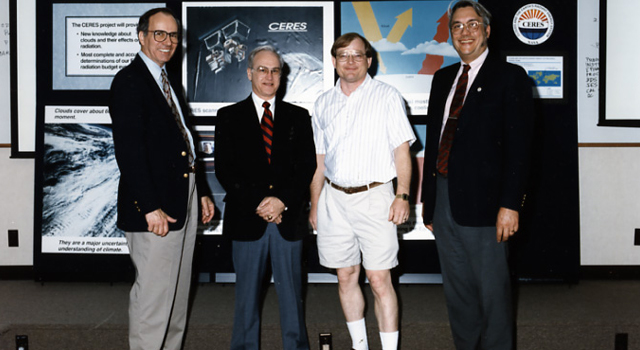Stories
42 Years of Measuring the Sun, the Earth and the Energy in Between

On Jan. 31, 1958, Explorer 1 became the first satellite launched by the United States. Its primary science instrument, a cosmic ray detector, was designed to measure the radiation environment in Earth orbit. Though its final transmission was in May 1958, it continued to revolve around Earth more than 58,000 times. As those looping orbits continued, NASA was busy building other ground-breaking instruments to observe and better understand Earth’s systems.
By 1975, just five years after Explorer 1 burned up as it entered Earth’s atmosphere, NASA’s first Nimbus instrument launched, providing the first global, direct observations of the amount of solar radiation entering and exiting Earth. This helped confirm and improve the earliest climate models and laid the groundwork for NASA’s Earth Radiation Budget Experiment (ERBE).
By the 1970s, the ERBE team was beginning to plan for the next phase of Earth Radiation Budget measurements. Retired experiment scientist for ERBE, Bruce Barkstrom, recalled the very first ERBE science team meeting involved a full day of attempting to determine exactly where the top of the atmosphere was. After much debate, they assigned one person at NASA’s Langley Research Center in Hampton, Virginia, to develop the number, which ended up being about 18 miles (30 kilometers) above the sphere that forms the Earth.
“That was the level of detail we had to get into as a science team,” Barkstrom said.
In October 1984, ERBE launched aboard NASA’s Earth Radiation Budget Satellite (ERBS) from the space shuttle Challenger (STS-41G).
“We had to get up at 3:30 a.m. to watch the ERBS launch at 7:30 a.m., and what I remember about that particular morning was that we had an overcast sky. And when the shuttle lit up, it was such a bright exhaust that it lit up the whole sky from underneath,” Barkstrom recalled. “And then, of course, the shuttle went through the clouds, and the light dimmed, and probably about a minute later the sky lit up again because the sun was reflected off the exhaust.
“It’s impossible for me to describe this without getting a little emotional.”

For 10 years, ERBE provided invaluable data for scientists studying the energy interactions between the Sun, clouds and Earth. Its satellite measurements have provided new information on Earth's radiation at the top of the atmosphere, including the important radiative effects of clouds on incoming and outgoing energy in the overall process.
In the late 1980s, satellite instruments provided the first direct observation that clouds cooled Earth’s climate. Former CERES Principal Investigator Bruce Wielicki developed an algorithm to apply to Nimbus and ERBE models to help quantify cloud forcing — the difference between the radiation budget components for average cloud conditions and cloud-free conditions.
With new knowledge about the important role that clouds play in Earth’s energy budget, the science team was anxious to gather more data. In 1997, the first in a new series of instruments, the Clouds and the Earth’s Radiant Energy System (CERES), launched, extending the important ERBE measurements.
Six other CERES instruments have since been activated in space to measure the solar energy reflected by Earth, the heat the planet emits, and the role of clouds in that process.
“The CERES instrument is small, it’s very elegant, it’s probably the most accurate radiometry that NASA has flown,” said CERES Principal Investigator Kory Priestley. “We’re trying to build the next generation of instrument now to meet the same requirements.”
The seventh and final CERES instrument launched aboard NOAA’s Joint Polar Satellite System (JPSS)-1 in November 2017. It has since been activated and first light is expected in January 2018.
For 42 years, NASA has observed Earth’s energy budget. NASA Langley’s Earth Radiation Budget Science Team is the only group producing ERB data globally. Though our understanding of Earth’s energy budget and the technology used to gather data has taken massive strides since Explorer 1 and Nimbus, that understanding is ever-evolving.
“With Earth observations, you never complete your understanding, so you’re always at the mercy of somebody discovering some new things,” Barkstrom said. “If you’re dealing with observational science, you never have that final escape into absolute certainty where you’ll never have to change things.”
Why Measure Earth’s Energy Budget?
According to Barkstrom, attempts to understand the radiation budget started in about 1880. Earth's energy budget is a metaphor for the delicate equilibrium between energy from the Sun versus energy radiated back into space. Continuous, stable and accurate data records over decades are critical to understanding Earth’s energy balance.
The data collected improve models that provide seasonal and longer-term forecasts, which inform industry and policy makers to better plan for the future.
The Latest
NASA's Total and Spectral Solar Irradiance Sensor (TSIS)-1 is currently on the International Space Station in a mission to measure the Sun's energy input to Earth.
Various satellites have captured a continuous record of this solar energy input since 1978. TSIS-1 sensors advance previous measurements, enabling scientists to study the Sun’s natural influence on Earth’s ozone layer, atmospheric circulation, clouds and ecosystems.
These observations are essential for a scientific understanding of the effects of solar variability on the Earth system.
